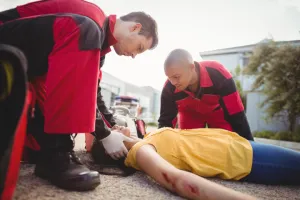Providing or Requesting First Aid
Slips, trips and falls account for over 30% of workplace injuries in the UK (HSE). Many of these could be prevented with one simple measure: wearing the right footwear. As a security officer, you are often on your feet for long hours, indoors and outdoors, in all kinds of weather and flooring conditions. Choosing footwear that’s safe, comfortable, and compliant is not just about comfort — it’s about protecting yourself, your colleagues, and the public.

As a frontline security officer, your role isn’t limited to monitoring CCTV or checking passes—it often extends to being the first person on the scene when accidents happen. Slips, trips and falls can happen anywhere: in shopping centres, car parks, warehouses, or office receptions. In those moments, people look to you for calmness, leadership, and action.
Knowing how to provide or request first aid is about three things: protecting life, maintaining professionalism, and keeping your site legally compliant.
Why First Aid Is Part of Security Work
People place a natural trust in you because of the uniform. When someone falls, faints, or suffers an injury, it’s usually the security officer who is expected to step forward and take charge. This expectation isn’t just about authority—it’s about reassurance. In moments of panic, people need a calm figure who knows what to do and can bring order to a chaotic scene.
Did you know? According to the HSE, slips, trips and falls account for around 95% of major slips-related injuries every year in the UK. These include broken bones, head injuries, and spinal damage. The majority occur in public-facing workplaces such as shopping centres, hotels, or office receptions—exactly the environments where security officers are deployed.
Providing or requesting first aid is therefore not just an optional skill but a key part of your professional role. Quick action from you can prevent further injury, reduce the severity of harm, and even save a life. It also shows professionalism to the public, reassures your employer of your competence, and helps meet legal obligations under UK health and safety regulations.
Tip: First aid is as much about confidence as it is about skill. People feel safer when you sound in control—even if all you are doing is reassuring them and calling for help.
Legal and Industry Expectations
While you don’t need to memorise every regulation word for word, here are the key frameworks that shape your responsibilities:
Health and Safety at Work etc. Act 1974 (HASAWA): Employers must provide a safe workplace and appropriate first-aid arrangements. As a security officer, you support this duty by acting quickly and responsibly.
First Aid Regulations 1981 (as amended): Employers must ensure that trained personnel, facilities, and equipment are available for first aid. You may be one of those trained personnel.
HSE Guidance (INDG347): Offers practical steps on first aid at work—helpful context when assessing risks in your environment.
SIA Standards: While not medical regulators, the Security Industry Authority expects licence holders to operate professionally and with duty of care, which includes responding appropriately to accidents.
BSI & NSI Codes of Practice: These emphasise professional conduct, preparedness, and safety management, which extend to first aid readiness.
The Security Officer’s First Aid Steps
When an incident happens, follow this simple but powerful sequence. Think of it as your personal action checklist—calm, clear and professional.
1. Check the Scene
Before you go near the casualty, scan the area. A wet floor, trailing cables, moving vehicles, or even panicking crowds can put you in danger. Your safety comes first, because if you get hurt, nobody wins.
Example: At a depot, an officer spotted spilt oil near a fallen worker. Instead of rushing in, he blocked the area off, called maintenance, and then approached safely.
Tip: Train your eyes to scan up, down and around. Hazards can be anywhere—slippery tiles underfoot, loose shelving above, or even broken glass nearby.
2. Check the Person
Once it’s safe, turn your attention to the casualty. Are they awake? Breathing? In pain? Bleeding? Stay calm, crouch down, and talk to them in a steady voice.
Example: A shopper collapsed near an entrance. The officer asked, “Can you hear me?” and “What’s your name?”—simple questions that helped confirm consciousness.
Tip: Don’t mistake silence for unconsciousness. Shock can make people quiet or frozen. Keep speaking gently—it often brings a reaction.
3. Act Within Your Training
Only do what you’ve been taught. If you’ve had first aid training, put it to use: apply pressure to bleeding, place someone in the recovery position, or use CPR if you’re qualified. If you haven’t, don’t guess—focus on reassurance and keeping the area controlled.
Example: One officer with CPR training saved a contractor’s life after cardiac arrest. Another without training focused on crowd control until medics arrived—both roles were vital.
Tip: Your words can be medicine too. Calm reassurance lowers panic, slows breathing, and makes it easier for professionals to step in.
4. Call for Help
Never delay getting extra help. Use your radio, phone, or alarm system to alert first aiders, supervisors, or emergency services. Give clear, structured information: who, what, where, and condition.
Example: Instead of saying “It’s bad,” say: “Male, 40s, unconscious after fall, bleeding from head, ground floor lobby, north entrance.”
Tip: Practise giving directions on your site as if guiding someone who’s never been there before. In an emergency, clarity saves minutes—and minutes save lives.
5. Report the Incident
After the situation is under control, log everything. Your report may later support medical teams, police, or even legal investigations. Include times, what you saw, what you did, and who you called.
Example: A company avoided legal penalties because the officer’s clear, factual report matched both CCTV and medical records.
Tip: Stick to facts, not guesses. “Casualty was holding his arm and said it hurt” is better than “I think his arm was broken.”
Communicating Under Pressure
First aid is 50% action and 50% communication. How you speak makes a huge difference.
With the casualty: Reassure them: “You’re safe, I’m staying with you. Help is coming.”
With bystanders: Delegate tasks: “You—please fetch the first aid kit. You—stand by the entrance to guide the ambulance.”
With colleagues: Be precise: avoid vague terms like “bad” or “serious.” Instead, describe symptoms.
Example: During a busy match day, an officer calmly controlled a crowd by keeping his voice steady and delegating jobs, while another officer treated the casualty.
Tip: Use short, simple sentences under stress. People process fewer words when they’re panicked.
Protecting Yourself While Helping
Your safety matters too. Injuries or contamination risks can happen quickly if you’re not careful.
Always wear gloves for blood or fluids.
Wash hands thoroughly after incidents.
Use barriers (like coats or bags) if equipment isn’t nearby.
Avoid lifting casualties unless absolutely necessary.
Example: An officer avoided injury by refusing to lift a fallen contractor alone, waiting instead for paramedics with stretchers.
Tip: Remember—you can’t help if you become casualty number two.
Common Mistakes to Avoid
Even experienced officers sometimes slip up in emergencies. Here are five frequent mistakes:
Panicking – speaking too fast or making sudden moves.
Overstepping training – attempting medical procedures they aren’t qualified for.
Forgetting personal safety – no gloves, bending badly, entering unsafe areas.
Poor reporting – writing vague or inaccurate logs.
Not calling for help early – losing precious minutes.
Tip: If in doubt, stop, breathe, and go back to basics: Scene – Person – Help.
Why Acting Matters
When accidents happen, hesitation or inaction can be just as harmful as the incident itself. As a security officer, people depend on you to make the first move. Failing to act has serious consequences—not only for the injured person, but also for you and your employer.
For the casualty: Injuries can quickly worsen if no one steps in. A minor fall can lead to long-term damage, shock, or even death if left untreated. Every minute counts.
For you professionally: Your duty of care is tied to your SIA licence. Ignoring someone in need could be seen as negligence, risking both your credibility and your career.
For your employer: Companies are legally accountable under HSE rules. If staff fail to respond properly, the organisation could face fines, investigations, or reputational damage that affects everyone.
But the flip side is powerful: taking calm, sensible action makes you the difference-maker. You don’t need to be a doctor—your role is to be prepared, stay composed, and follow your training. Even small steps, like reassuring a casualty or making the emergency call quickly, can protect lives and show professionalism.
Tip: In an emergency, silence or delay can cost lives. Acting quickly, even with simple steps, is always better than doing nothing.
Remember: You are the first link in the chain of survival. Your quick actions protect the casualty, protect your licence, and protect your site.

